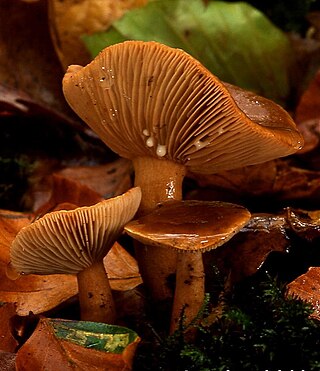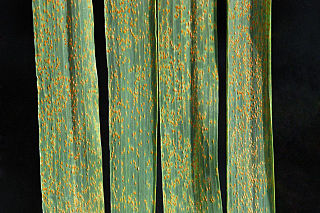
Mycology is the branch of biology concerned with the study of fungi, including their genetic and biochemical properties, their taxonomy and their use to humans, including as a source for tinder, traditional medicine, food, and entheogens, as well as their dangers, such as toxicity or infection.

Penicillium is a genus of ascomycetous fungi that is part of the mycobiome of many species and is of major importance in the natural environment, in food spoilage, and in food and drug production.

The genus Amanita contains about 600 species of agarics, including some of the most toxic known mushrooms found worldwide, as well as some well-regarded edible species. This genus is responsible for approximately 95% of the fatalities resulting from mushroom poisoning, with the death cap accounting for about 50% on its own. The most potent toxin present in these mushrooms is α-Amanitin.

The Boletaceae are a family of mushroom-forming fungi, primarily characterised by small pores on the spore-bearing hymenial surface, instead of gills as are found in most agarics. Nearly as widely distributed as the agarics, the family is renowned for hosting some prime edible species highly sought after by mushroom hunters worldwide, such as the cep or king bolete . A number of rare or threatened species are also present in the family, that have become the focus of increasing conservation concerns. As a whole, the typical members of the family are commonly known as boletes.

In mycology, a lamella, or gill, is a papery hymenophore rib under the cap of some mushroom species, most often agarics. The gills are used by the mushrooms as a means of spore dispersal, and are important for species identification. The attachment of the gills to the stem is classified based on the shape of the gills when viewed from the side, while color, crowding and the shape of individual gills can also be important features. Additionally, gills can have distinctive microscopic or macroscopic features. For instance, Lactarius species typically seep latex from their gills.

The Leotiomycetes are a class of ascomycete fungi. Many of them cause serious plant diseases.

Petter Adolf Karsten was a Finnish mycologist, the foremost expert on the fungi of Finland in his day, and known in consequence as the "father of Finnish mycology".
Hyphochytrids are eukaryotic organisms in the group of Stramenopiles (Heterokonta).
Sphaceloma arachidis is a plant pathogen infecting peanuts.
Sphaceloma perseae is a plant-pathogenic fungus in the division Ascomycota. It infects the avocado plant, a tree native to Central America and Mexico. Currently there are three cultivars of avocados in large-scale agricultural production: Guatemalan, Mexican, and West Indian. The pathogen is currently limited to the P. Americana species but is able to infect all three cultivars. The resulting disease is known as avocado scab for the symptoms which are present on the fruit of the avocado tree. It is believed that the disease developed in Florida in the early twentieth century and is related to citrus scab, Elsinoe fawcetti. Since then, S.perseae has spread to many regions worldwide that support cultivation of the avocado tree. This pathogen threatens the global avocado market, including both importers and exporters of the crop. Countries which import avocados, including the United States, have experienced a rising demand over the past decade which is projected to continue for years to come. An understanding of avocado scab characteristics and feasible prevention methods is essential to maintenance of cultures and economies influenced by the avocado fruit.

Puccinia is a genus of fungi. All species in this genus are obligate plant pathogens and are known as rusts. The genus contains about 4000 species.

The Hymenogastraceae is a family of fungi in the order Agaricales with both agaric and false-truffle shaped fruitbodies. Formerly, prior to molecular analyses, the family was restricted to the false-truffle genera. The mushroom genus Psilocybe in the Hymenogastraceae is now restricted to the hallucinogenic species while nonhallucinogenic former species are largely in the genus Deconica classified in the Strophariaceae.

The corticioid fungi are a group of fungi in the Basidiomycota typically having effused, smooth basidiocarps that are formed on the undersides of dead tree trunks or branches. They are sometimes colloquially called crust fungi or patch fungi. Originally such fungi were referred to the genus Corticium and subsequently to the family Corticiaceae, but it is now known that all corticioid species are not necessarily closely related. The fact that they look similar is an example of convergent evolution. Since they are often studied as a group, it is convenient to retain the informal (non-taxonomic) name of "corticioid fungi" and this term is frequently used in research papers and other texts.

The clavarioid fungi are a group of fungi in the Basidiomycota typically having erect, simple or branched basidiocarps that are formed on the ground, on decaying vegetation, or on dead wood. They are colloquially called club fungi and coral fungi.
Anna Eliza Jenkins was an American mycologist. She specialized in phytopathology, particularly the fungi responsible for "spot anthracnoses", including Sphaceloma and Elsinoe.
Amanita pallidorosea is a mushroom of the large genus Amanita, which occurs under beech and pine in China and Japan. It is closely related to the destroying angel A. bisporiga.
Amanita subfuliginea is a mushroom of the large genus Amanita, which occurs central and southern China. It is closely related to the east Asian death cap A. fuliginea.
Amanita griseorosea is a mushroom of the large genus Amanita, which occurs under beech in southern China. It is closely related to A. molliuscula.
Amanita molliuscula is a mushroom of the large genus Amanita, which occurs under beech in Shaanxi Province in China. It is closely related to A. griseorosea.










